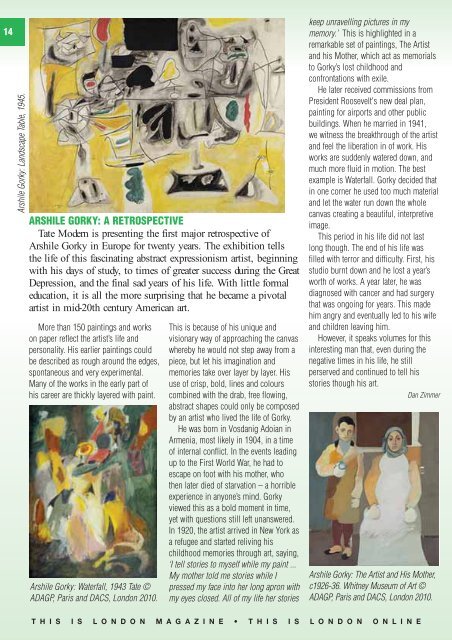A show of paintings by John Speirs, Oleg Tyrkin and Auguste Rodin ...
A show of paintings by John Speirs, Oleg Tyrkin and Auguste Rodin ...
A show of paintings by John Speirs, Oleg Tyrkin and Auguste Rodin ...
You also want an ePaper? Increase the reach of your titles
YUMPU automatically turns print PDFs into web optimized ePapers that Google loves.
14<br />
Arshile Gorky: L<strong>and</strong>scape Table, 1945.<br />
ARSHILE GORKY: A RETROSPECTIVE<br />
Tate Modern is presenting the first major retrospective <strong>of</strong><br />
Arshile Gorky in Europe for twenty years. The exhibition tells<br />
the life <strong>of</strong> this fascinating abstract expressionism artist, beginning<br />
with his days <strong>of</strong> study, to times <strong>of</strong> greater success during the Great<br />
Depression, <strong>and</strong> the final sad years <strong>of</strong> his life. With little formal<br />
education, it is all the more surprising that he became a pivotal<br />
artist in mid-20th century American art.<br />
More than 150 <strong>paintings</strong> <strong>and</strong> works<br />
on paper reflect the artist’s life <strong>and</strong><br />
personality. His earlier <strong>paintings</strong> could<br />
be described as rough around the edges,<br />
spontaneous <strong>and</strong> very experimental.<br />
Many <strong>of</strong> the works in the early part <strong>of</strong><br />
his career are thickly layered with paint.<br />
Arshile Gorky: Waterfall, 1943 Tate ©<br />
ADAGP, Paris <strong>and</strong> DACS, London 2010.<br />
This is because <strong>of</strong> his unique <strong>and</strong><br />
visionary way <strong>of</strong> approaching the canvas<br />
where<strong>by</strong> he would not step away from a<br />
piece, but let his imagination <strong>and</strong><br />
memories take over layer <strong>by</strong> layer. His<br />
use <strong>of</strong> crisp, bold, lines <strong>and</strong> colours<br />
combined with the drab, free flowing,<br />
abstract shapes could only be composed<br />
<strong>by</strong> an artist who lived the life <strong>of</strong> Gorky.<br />
He was born in Vosdanig Adoian in<br />
Armenia, most likely in 1904, in a time<br />
<strong>of</strong> internal conflict. In the events leading<br />
up to the First World War, he had to<br />
escape on foot with his mother, who<br />
then later died <strong>of</strong> starvation – a horrible<br />
experience in anyone’s mind. Gorky<br />
viewed this as a bold moment in time,<br />
yet with questions still left unanswered.<br />
In 1920, the artist arrived in New York as<br />
a refugee <strong>and</strong> started reliving his<br />
childhood memories through art, saying,<br />
‘I tell stories to myself while my paint ...<br />
My mother told me stories while I<br />
pressed my face into her long apron with<br />
my eyes closed. All <strong>of</strong> my life her stories<br />
keep unravelling pictures in my<br />
memory.’ This is highlighted in a<br />
remarkable set <strong>of</strong> <strong>paintings</strong>, The Artist<br />
<strong>and</strong> his Mother, which act as memorials<br />
to Gorky’s lost childhood <strong>and</strong><br />
confrontations with exile.<br />
He later received commissions from<br />
President Roosevelt's new deal plan,<br />
painting for airports <strong>and</strong> other public<br />
buildings. When he married in 1941,<br />
we witness the breakthrough <strong>of</strong> the artist<br />
<strong>and</strong> feel the liberation in <strong>of</strong> work. His<br />
works are suddenly watered down, <strong>and</strong><br />
much more fluid in motion. The best<br />
example is Waterfall. Gorky decided that<br />
in one corner he used too much material<br />
<strong>and</strong> let the water run down the whole<br />
canvas creating a beautiful, interpretive<br />
image.<br />
This period in his life did not last<br />
long though. The end <strong>of</strong> his life was<br />
filled with terror <strong>and</strong> difficulty. First, his<br />
studio burnt down <strong>and</strong> he lost a year’s<br />
worth <strong>of</strong> works. A year later, he was<br />
diagnosed with cancer <strong>and</strong> had surgery<br />
that was ongoing for years. This made<br />
him angry <strong>and</strong> eventually led to his wife<br />
<strong>and</strong> children leaving him.<br />
However, it speaks volumes for this<br />
interesting man that, even during the<br />
negative times in his life, he still<br />
perserved <strong>and</strong> continued to tell his<br />
stories though his art.<br />
Dan Zimmer<br />
Arshile Gorky: The Artist <strong>and</strong> His Mother,<br />
c1926-36. Whitney Museum <strong>of</strong> Art ©<br />
ADAGP, Paris <strong>and</strong> DACS, London 2010.<br />
T H I S I S L O N D O N M A G A Z I N E • T H I S I S L O N D O N O N L I N E


